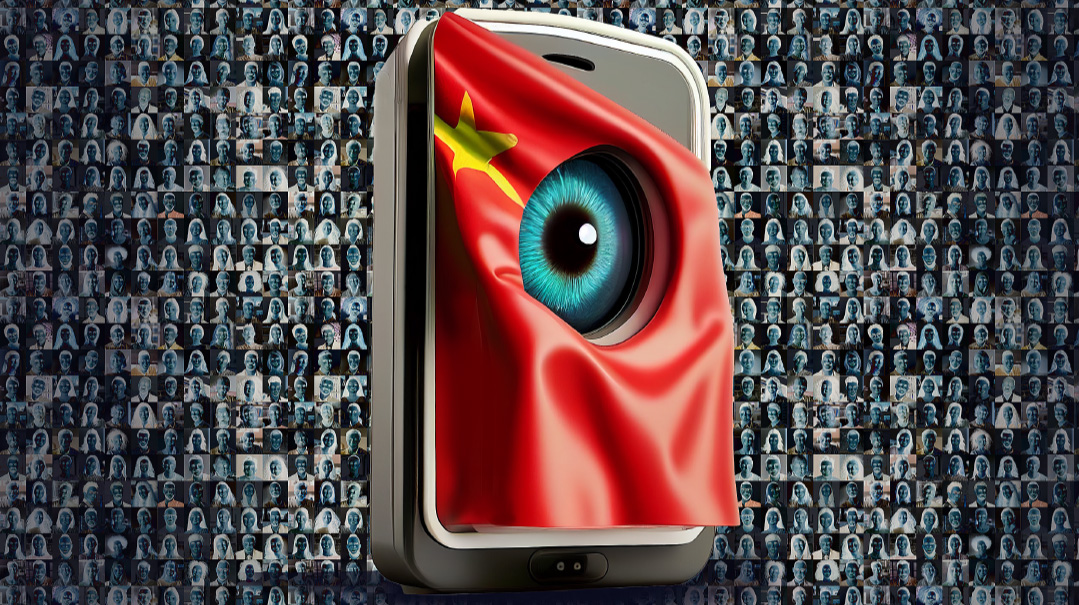Eye Spy
| January 24, 2023An insider’s report on the Chinese surveillance state

Digital Artwork: Menachem Weinreb
Photos: AP Newsroom
Geoffrey Cain entered China on a tourist visa, posing as a backpacker. His true intent: to observe the world’s most advanced all-seeing surveillance state up close.
Now that he’s seen the terrifying scope of China’s surveillance state, Cain has a warning for America. The Chinese state, he says, is spreading its long arm westward via a Trojan horse implanted in the phones of 138 million US citizens.
“See a terrorist, strike a terrorist!” shouted the policeman.
He was one of three burly counterterrorism officers at an outdoor market in the city of Kashgar in the far-western Chinese province of Xinjiang, training store owners how to bring down a terrorist. At the ring of a bell, they began the drill: strike hard, strike fast, and pin an imaginary terrorist on the ground.
It was December 2017 and Geoffrey Cain, an expert on the rise of China’s surveillance state, had entered the country on a tourist visa. He was posing as a backpacker and had arrived in Kashgar to see the world’s most advanced all-seeing surveillance state up close.
Cain, in the manner of tourists the world over, casually snapped a picture of the bizarre scene, and began walking away. But in true dystopian sci-fi fashion, one of the officers was wearing sunglasses with a built-in camera connected to SkyNet, China’s central surveillance database, through which the country’s 200 million AI-equipped security cameras are linked. Before Cain knew it, he was surrounded by police.
Cain had just experienced firsthand the reach of China’s surveillance program, which, in 2017, was still limited to Xinjiang and Tibet, though it has now been extended across China. SkyNet stores the DNA, voices, and social ranking of Chinese citizens, and the absence of details under Cain’s profile flagged him immediately as a foreigner.
Cain escaped with a warning, but he was only too aware that the outcome for the “terrorists” these locals were being trained to subdue would have been very different. He had been spotted with the most sophisticated and intrusive surveillance system the world had yet known, with Xinjiang as its testing ground and the Uighur Muslims as its first subjects. It would soon spread to the rest of China, and further fortify the high-tech police state the country has become under its strongman leader, Xi Jinping.
Now, Cain is warning that the Chinese state is spreading its long arm westward via a Trojan horse implanted in the phones of 138 million US citizens — TikTok.
The social media app, one of the fastest growing in the world, is American, but its parent company, ByteDance, is Chinese, and has a multiyear history of collaboration with the Chinese Ministry of Public Security. With its privacy policy explicitly stating that user data may be shared with its parent company, TikTok feeds a vast amount of sensitive information about the West’s Gen Z to the Chinese government.
There is no doubt that China views TikTok as an important weapon in its arsenal against the West. The proof is that China would take drastic steps to avoid separating the two companies.
A former TikTok employee summed it up for Cain: “It’s an American company on paper, but it’s a Chinese company underneath.”
The increasing popularity of TikTok for political campaigns is adding to the national security concerns already being raised, with FBI director Chris Wray adding his voice to those sounding the alarm.
Having seen up close the terrifying scope of China’s surveillance state, Geoffrey Cain has warned about the danger of a Chinese subsidiary playing a pivotal role in democratic processes, and applauds recent moves to legislate against TikTok.
“It’s about time,” he concludes.
Oops! We could not locate your form.







